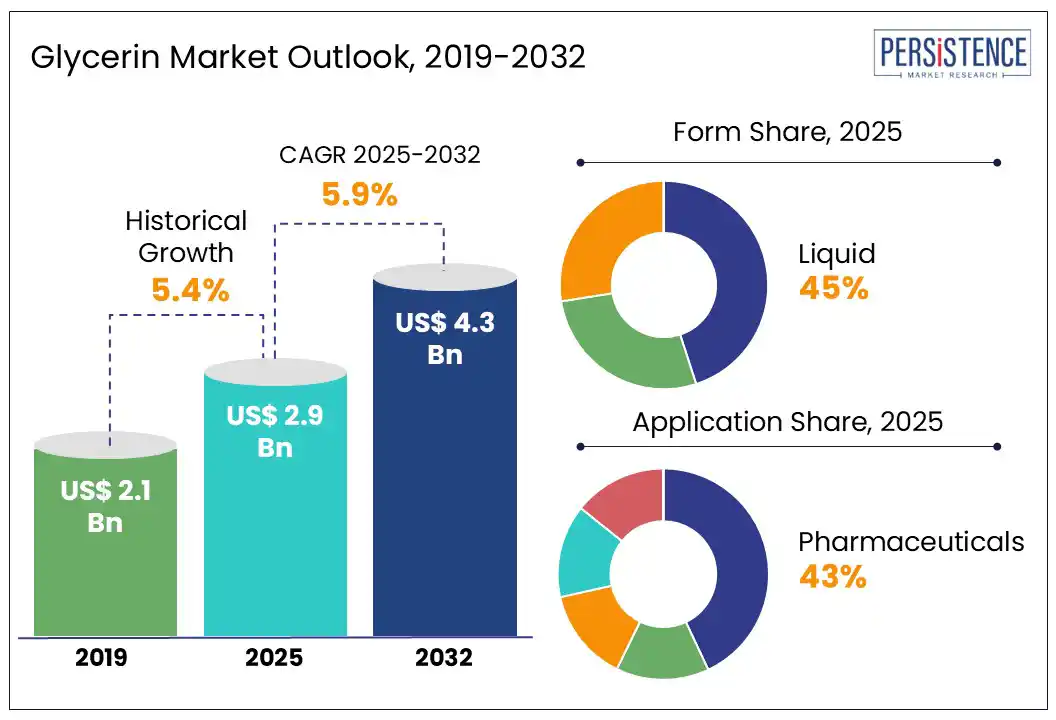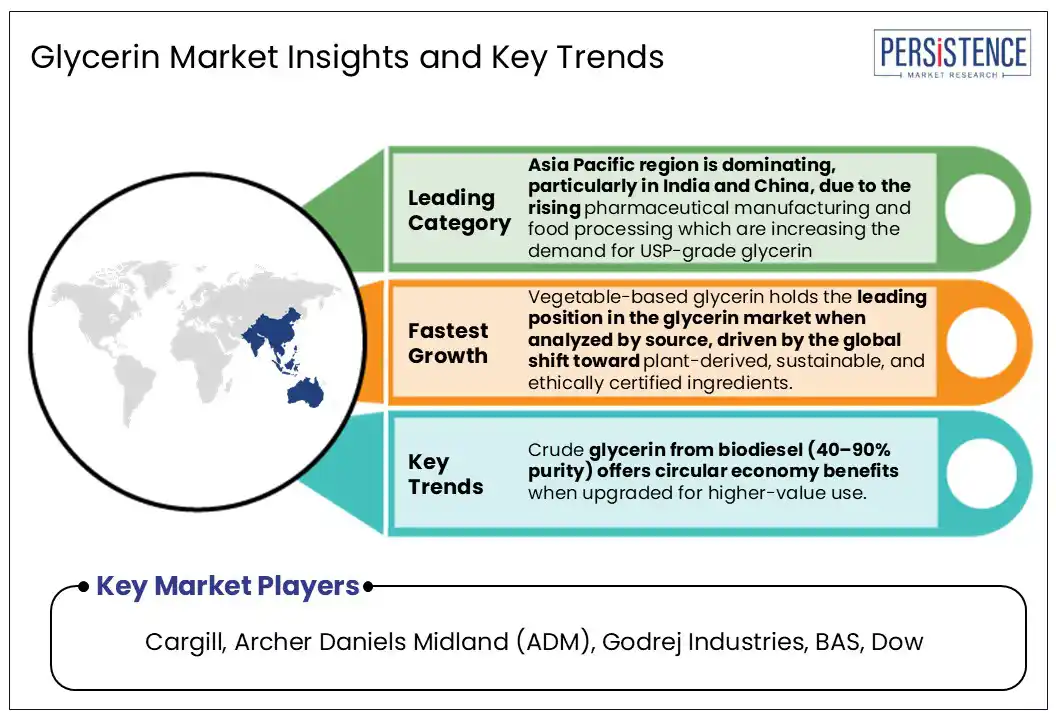ID: PMRREP3553| 194 Pages | 8 Jul 2025 | Format: PDF, Excel, PPT* | Chemicals and Materials

The global glycerin market size is likely to be valued at US$ 2.9 Bn in 2025 and is expected to reach US$ 4.3 Bn by 2032, growing at a CAGR of 5.9% from 2025 to 2032.
According to Persistence Market Research report, the glycerin market is driven by its widespread use in personal care, food, pharmaceutical, and industrial applications. Derived from vegetable oils, animal fats, or biodiesel byproducts, glycerin's versatility, safety, and humectant properties make it a valuable ingredient across industries, supported by increasing demand for sustainable, multifunctional materials.

Key Industry Highlights
|
Global Market Attribute |
Key Insights |
|
Glycerin Market Size (2025E) |
US$ 2.9 Bn |
|
Market Value Forecast (2032F) |
US$ 4.3 Bn |
|
Projected Growth (CAGR 2025 to 2032) |
5.9% |
|
Historical Market Growth (CAGR 2019 to 2024) |
5.4% |
The growing demand for natural and sustainable cosmetics is a key driver propelling global glycerin consumption. As consumers increasingly prefer clean-label, plant-based skincare and personal care products, glycerin, especially vegetable-derived, is favored for its moisturizing, non-toxic, and eco-friendly profile. Its ability to act as a natural humectant aligns well with green beauty formulations.
Drunk Elephant’s recently launched B-Hydra serum features plant-based glycerin in a silicone- and fragrance-free formulation designed to deeply hydrate dull, thirsty skin. Marketed under the clean beauty banner, it reflects the brand’s commitment to bioavailable, non-toxic skincare that meets modern demands for vegan, cruelty-free, and effective hydration solutions.
Regulatory encouragement for safer cosmetic ingredients further supports glycerin’s adoption in creams, lotions, soaps, and haircare products. Brands are reformulating to eliminate synthetic additives, enhancing glycerin’s relevance. This shift toward sustainability in the cosmetics industry is significantly expanding glycerin’s role as a preferred multifunctional ingredient worldwide.
Fluctuating biodiesel production volumes act as a significant restraint on the glycerin market by creating instability in the supply of crude glycerin, a major byproduct of biodiesel synthesis. Since approximately 10% of biodiesel output yields crude glycerin, any variation in biodiesel production due to feedstock shortages, policy shifts, or fuel demand changes directly affects glycerin availability.
This unpredictability poses challenges for industries reliant on a steady supply of crude or technical-grade glycerin for chemical, resin, and antifreeze applications. As a result, companies face difficulties in planning procurement and pricing, hindering long-term contracts and scalability in industrial glycerin-based product development.
Rising demand for glycerin-derived chemical intermediates presents a significant opportunity for producers to diversify into the specialty chemicals sector. Glycerin can be converted into high-value compounds such as epichlorohydrin, 1,3-propanediol, and acrolein widely used in resins, plastics, solvents, and coatings.
Solvay developed the EPICEROL® process, which uses 100% renewable glycerin instead of traditional petrochemical sources like propylene. This bio-based route supports sustainability goals and reduces carbon footprint, making it a preferred choice for industries manufacturing epoxy resins, coatings, and specialty polymers seeking greener alternatives.
With increasing emphasis on sustainable and bio-based feedstocks, industries are shifting from petrochemical inputs to renewable alternatives like glycerin. This transition supports circular economy goals and adds value to surplus crude glycerin, especially from biodiesel production. By investing in catalytic conversion and downstream processing, manufacturers can tap into emerging markets with higher margins and long-term growth potential in green chemistry.
Vegetable-based glycerin holds the leading position in the glycerin market when analyzed by source, driven by the global shift toward plant-derived, sustainable, and ethically certified ingredients. Extracted from oils such as palm, soybean, and coconut, vegetable glycerin is widely accepted across the personal care, food, and pharmaceutical industries. Its compatibility with halal, kosher, vegan, and clean-label standards has made it the preferred choice among consumers and manufacturers alike. Unlike animal- or synthetic-based alternatives, it aligns with cultural, dietary, and environmental expectations, particularly in regions like North America, Europe, and Southeast Asia, where demand for ethical and plant-based products continues to grow.
USP/pharmaceutical-grade glycerin holds the highest demand across multiple industries due to its certified purity, safety, and compliance with global regulatory standards. With a minimum purity of 99.5%, it is widely used in food as a humectant and sweetener (E422), in pharmaceuticals for syrups, suppositories, and topical treatments, and in personal care products such as moisturizers and creams. Its designation under the U.S. Pharmacopeia and inclusion in the European Pharmacopoeia ensure its acceptability in highly regulated environments, particularly where ingestion, skin contact, or medical use is involved.
For example, CeraVe Moisturizing Lotion features USP-grade glycerin as a primary humectant, helping to attract and retain moisture in the skin, and is developed for sensitive, dry skin with pharmaceutical-grade safety standards. Similarly, Aquaphor Healing Ointment includes pharmaceutical-grade glycerin known for its intensive moisturizing and skin-repairing properties, making it ideal for cracked, irritated, or pediatric skin due to its gentle, fragrance-free formulation.
Together, these examples highlight the grade’s versatility and essential role in trusted, high-performance health and personal care products.

In North America, particularly in the United States, the rising production of plant-based personal care and wellness products is significantly driving the demand for vegetable-derived glycerin. As consumers increasingly prioritize clean, vegan, and cruelty-free beauty formulations, manufacturers are replacing synthetic and animal-derived ingredients with naturally sourced alternatives like glycerin from soybean, coconut, or palm oils. This shift aligns with broader sustainability goals and ethical consumer preferences.
For example, Native’s U.S.-marketed body wash uses vegetable-derived glycerin in its vegan, sulfate-free formula. Marketed as a clean-label product, it meets growing consumer demand for naturally sourced, ethical skincare products.
Dr. Bronner’s soap includes vegetable glycerin produced from organic coconut and olive oils. Certified vegan and USDA Organic, it exemplifies the shift toward bio-based, eco-friendly hygiene products in the U.S.
Regulatory frameworks such as FDA labeling standards and the popularity of USDA Organic and Non-GMO certifications further support the adoption of vegetable-based glycerin across skincare, cosmetics, and hygiene products in the region.
In the European Union, circular economy initiatives and advancements in glycerin-based biofuel technologies are significantly boosting demand for glycerin in industrial applications. As part of the EU’s Green Deal and Circular Economy Action Plan, industries are encouraged to valorize waste streams, such as crude glycerin from biodiesel production, into higher-value outputs like biofuels and chemical intermediates.
Projects like GLAMOUR, funded under Horizon 2020, are exploring catalytic and thermochemical processes to convert glycerin into sustainable aviation and marine fuels. This innovation-driven policy environment is expanding glycerin’s role beyond traditional uses, positioning it as a critical input in Europe’s green industrial transformation.
In the Asia Pacific region, particularly in India and China, rising pharmaceutical manufacturing and food processing industries are significantly increasing the demand for USP-grade glycerin. Both countries are major global hubs for generic drug production and processed food exports, where high-purity glycerin is essential as a safe humectant, solvent, and excipient. Regulatory compliance with pharmacopeial standards, including the U.S. Pharmacopeia (USP) and local equivalents, is further driving adoption.
As consumer awareness around ingredient safety and quality grows, manufacturers are shifting toward certified pharmaceutical-grade glycerin to meet both domestic and international regulatory requirements, accelerating its consumption in Asia Pacific’s rapidly expanding industrial landscape.
The global glycerin market is moderately fragmented, with competition shaped by access to feedstock, purification capabilities, and compliance with international quality standards. Key players span the value chain, from biodiesel producers supplying crude glycerin to refiners offering USP- and food-grade variants. Companies with integrated operations and strong sourcing from vegetable oils or biodiesel byproducts gain cost advantages.
Innovation in bio-based chemical conversions and circular economy practices is also influencing market leadership. Regulatory compliance, especially for pharmaceutical and food applications, is a major competitive factor. Sustainability credentials, including vegan, halal, and kosher certifications, are increasingly important in differentiating product offerings across regions.
The global glycerin market is projected to value at 2.9 bn in 2025.
The glycerin market is driven by growing demand for natural and sustainable cosmetics.
The glycerin market is poised to witness a CAGR of 5.9% between 2025 and 2032.
Rising demand for glycerin-derived chemical intermediates is the key market opportunity.
Major players in the glycerin market include Cargill, Archer Daniels Midland (ADM), Godrej Industries, BAS, Dow, and others.
|
Report Attributes |
Details |
|
Historical Data/Actuals |
2019 - 2024 |
|
Forecast Period |
2025 - 2032 |
|
Units |
Value: US$ Bn/Mn, Volume: As applicable |
|
Geographical Coverage |
|
|
Segmental Coverage |
|
|
Competitive Analysis |
|
|
Report Highlights |
|
|
Customization and Pricing |
Available upon request |
By Form
By Source
By Grade
By Application
By Region
Delivery Timelines
For more information on this report and its delivery timelines please get in touch with our sales team.
About Author